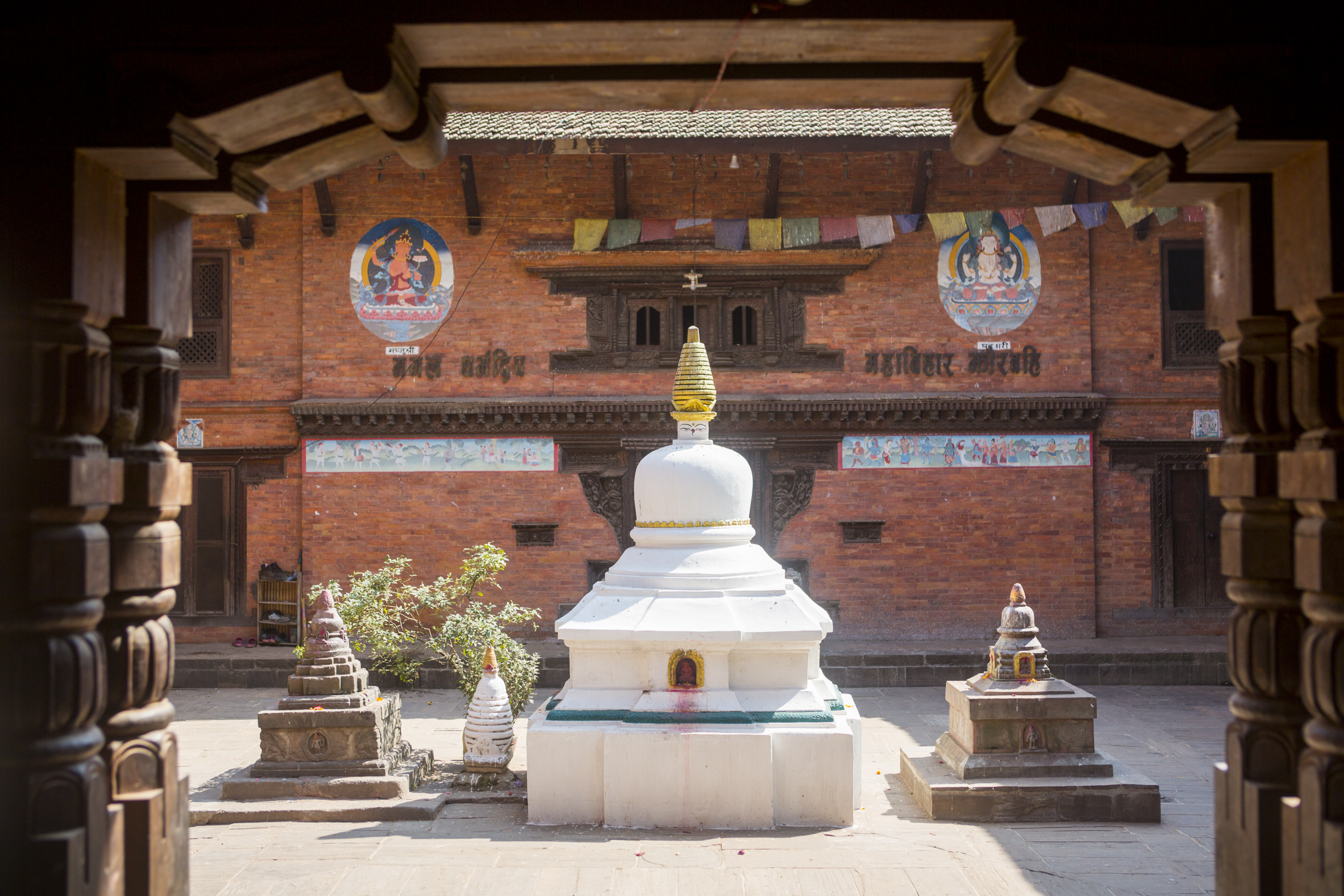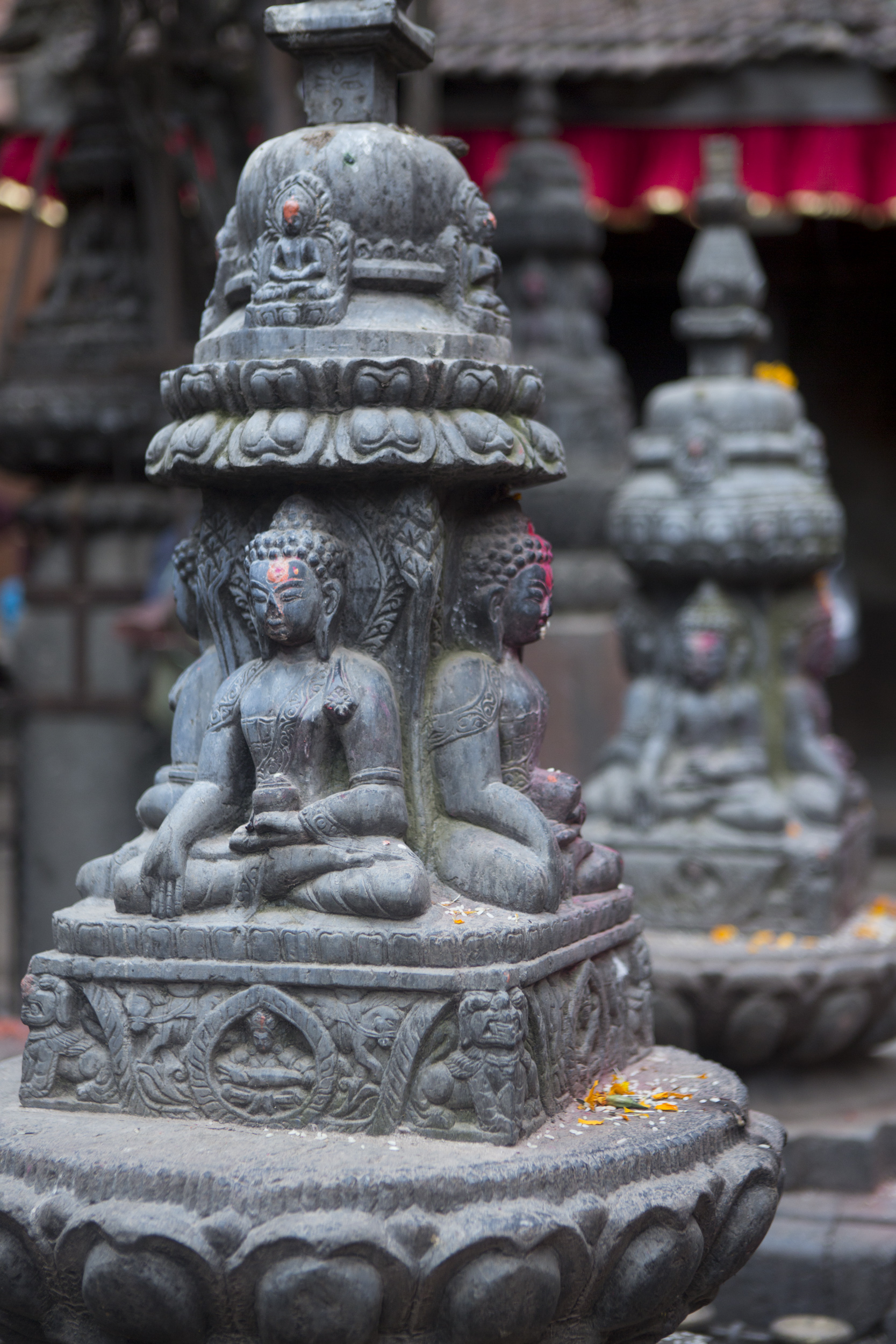Bhaktapur
Quest for the destined consort
“Following the Guru’s instructions, you travel to Nepal,
bring a corpse back to life, are rewarded with gold,
and ransom your consort of skilful means, Acharya Sale.
In such ways you are a guide for beings, so difficult to tame.
To you, we pray!”





AT A GLANCE
While wandering the brick-laden streets of the ancient Newar kingdom of Bhaktapur, Yeshé Tsogyal met her future consort, Arya Salé.
THE STORY
Khandro Yeshé Tsogyal
To visit Bhaktapur is to step back in time, to an age when Nepal was a collection of city states and small kingdoms replete with royal palaces and temple priests, encircled by winding lanes and local villages. There were countless shrines everywhere, sacred to the region’s clans. Khandro Yeshé Tsogyal, a woman of foreign looks and manners, yet a lady of magnificent bearing, once wandered these lanes. Indeed, her radiance left the locals speechless and in awe. It was here that another foreigner, a young Indian boy named Arya Salé, strolled up to Yeshé Tsogyal, giving birth to a relationship that would lead to vast benefits and spiritual accomplishments––first in Nepal and later in Tibet, Land of Snows.
How to get there
Bhaktapur lies in the southeastern corner of the valley. It can be reached easily by taxi, and is about a 45-minute drive from Boudha.
food and accommodation
Enjoy traditional Newar fare in the area’s many traditional restaurants. You are still technically in Kathmandu, and those staying in other parts of the city will make this a day-trip. If you wish to stay in Bhaktapur, the Peacock Guest House offers traditional Newar rooms next to the Dattatreya Temple, one of the oldest temples of this great Newar kingdom.
While at the main site
Bhaktapur, City of Devotees, once known in Tibetan as Khu-Khom or Kho-Khom, served as Nepal’s capital city during the reign of the Malla dynasty, up until the late 15th century. Today, Bhaktapur is known for its rich culture and temples, and its craftsmanship and artistry in wood, metal, and stone. Its many squares often feature reservoirs of water and are surrounded by temples. Unlike the people of Patan, the devout in Bhaktapur are mostly Hindu. Nevertheless, the city is home to several important Buddhist temples and monasteries.
Most Buddhist pilgrims visit Prashannashil Mahavihara, which enshrines a beautiful statue of Dipamkara, sometimes known as Red Tara. It is found just north of Dattatraya Square, which is named for the magnificent Dattaraya Temple, where there are statues of the Hindu trinity of Brahma, Vishnu, and Shiva. Since the precise location of the encounter between Khandro Yeshé Tsogyal and Arya Salé remains unknown, we can imagine the whole of Bhaktapur as the setting for their meeting. The following are a list of Buddhist sites to visit while in Bhaktapur:
Prashannashil Mahavihara - Map Location
Prashannashil Mahavihara, north of Dattatraya Square, enshrines the poignant and beautiful statue of Buddha Dipamkara, the Buddha of the previous eon, which some see as Red Tara.
Mangal Dharmadweep Mahavihar, Jhaur Bahi - Map Location
Jhaur Bahi is a temple enshrining a sacred statue of Buddha Shakyamuni.
Talking Tara - Map Location
“Talking Tara” is a statue that is believed to have spoken to the king, telling him to invite Milarepa to come. It is located in the King’s Palace, where even non-Hindus may enter.
Lokeshvara Vihara - Map Location
Lokeshvara Vihara enshrines a sacred statue of Avalokiteshvara, close to Itachhe Tol in Bhaktapur.
Beyond the main site
Milarepa Cave - Map Location
Milarepa meditated in a cave at Saraswati Sthan, located in the hills above the ancient town of Bhaktapur. Some believe this to be the place where Manjushri arrived, when he came from his mountain home of Wutai Shan in China, in the form of Vajracharya Manjudeva.
Thrangu Rinpoche built a retreat center here, known as Shekhar, just below the Milarepa cave - Map Location.
Changu Narayan - Map Location
Changu Narayan – the most important temple in the valley for devotees of Lord Vishnu – is located halfway between Bhaktapur and the village of Sankhu. It is one of the oldest temples of the valley. Its central image is a 7th century stone sculpture of Vishnu riding a Garuda. According to the 4th Khamtrul Rinpoche, this image is naturally self-arisen, and is thus called Khyung Rangjung Gyi Norbu, Jewel of the Naturally-Arisen Garuda.
Also according to Khamtrul Rinpoché, the common belief that the image arose from a mala bead belonging to Nagarjuna is incorrect. In fear of the original being destroyed, he says, it was brought to the King’s palace and a copper replacement put in its place. For Newars, the water in the well here is sacred. Also note that Padampa Sangyé had a hermitage close to Changu Narayan.
Visitors are not allowed into the temple, which was severely damaged in the 2015 earthquake, along with its surrounding buildings.


